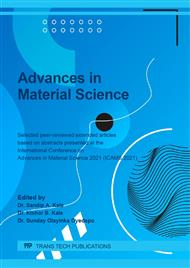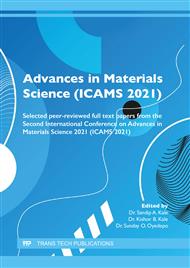[1]
D. Ozkan, M. S. Gok, and A. C. Karaoglanli, Carbon Fiber Reinforced Polymer (CFRP) Composite Materials, Their Characteristic Properties, Industrial Application Areas and Their Machinability,, in Engineering design applications, 2020, p.235–253.
DOI: 10.1007/978-3-030-39062-4_20
Google Scholar
[2]
D. Rajak, D. Pagar, P. Menezes, and E. Linul, Fiber-Reinforced Polymer Composites: Manufacturing, Properties, and Applications,, Polymers (Basel)., vol. 11, no. 10, p.1667, Oct. (2019).
DOI: 10.3390/polym11101667
Google Scholar
[3]
W. Liu, H. Huang, H. Cheng, and Z. Liu, CFRP Reclamation and Remanufacturing Based on a Closed-loop Recycling Process for Carbon Fibers Using Supercritical N-butanol,, Fibers Polym., vol. 21, no. 3, p.604–618, (2020).
DOI: 10.1007/s12221-020-9575-7
Google Scholar
[4]
X. Li, R. Bai, and J. McKechnie, Environmental and financial performance of mechanical recycling of carbon fibre reinforced polymers and comparison with conventional disposal routes,, J. Clean. Prod., vol. 127, p.451–460, Jul. (2016).
DOI: 10.1016/j.jclepro.2016.03.139
Google Scholar
[5]
A. Rahimizadeh, J. Kalman, K. Fayazbakhsh, and L. Lessard, Recycling of fiberglass wind turbine blades into reinforced filaments for use in Additive Manufacturing,, Compos. Part B Eng., vol. 175, p.107101, Oct. (2019).
DOI: 10.1016/j.compositesb.2019.107101
Google Scholar
[6]
S. Francis, The state of recycled carbon fiber,, Compositesworld.com. (2019).
Google Scholar
[7]
T. Stock and G. Seliger, Opportunities of Sustainable Manufacturing in Industry 4.0,, Procedia CIRP, vol. 40, p.536–541, (2016).
DOI: 10.1016/j.procir.2016.01.129
Google Scholar
[8]
C. Johnson, Impacts of Digitalization on Traceability A Case Study of the Carbon Fiber Supply Chain,, in The Digital Transformation of Logistics: Demystifying Impacts of the Fourth Industrial Revolution, IEEE Press, 2021, p.311–327.
DOI: 10.1002/9781119646495.ch22
Google Scholar
[9]
A. Meiirbekov, E. Shehab, A. Amantayeva, S. Tokbolat, A. Suleimen, and S. Sarfraz, Understanding Uncertainty in Recycling Carbon Fiber Reinforced Composite,, in The 18th International Conference on Manufacturing Research (ICMR 2021), 2021, p.166–171.
DOI: 10.3233/atde210031
Google Scholar
[10]
S. Black, Composites and Industry 4.0: Where are we?,, 2017. [Online]. Available: https://www.compositesworld.com/articles/composites-and-industry-40-where-are-we.
Google Scholar
[11]
Digitalization takes off at the boeing company: building a next generation supply chain,, Harvard Business School, 2017. [Online]. Available: https://digital.hbs.edu/platform-rctom/submission/digitalization-takes-off-at-the-boeing-company-building-a-next-generation-supply-chain/.
Google Scholar
[12]
S. Blömeke, J. Rickert, M. Mennenga, S. Thiede, T. S. Spengler, and C. Herrmann, Recycling 4.0 – Mapping smart manufacturing solutions to remanufacturing and recycling operations,, Procedia CIRP, vol. 90, p.600–605, (2020).
DOI: 10.1016/j.procir.2020.02.045
Google Scholar
[13]
M. Kerin and D. T. Pham, A review of emerging industry 4.0 technologies in remanufacturing,, J. Clean. Prod., vol. 237, p.0–37, (2019).
Google Scholar
[14]
R. Geiger, Y. Hannan, W. Travia, R. Naboni, and C. Schlette, Composite wind turbine blade recycling - value creation through Industry 4.0 to enable circularity in repurposing of composites,, IOP Conf. Ser. Mater. Sci. Eng., vol. 942, p.012016, Oct. (2020).
DOI: 10.1088/1757-899x/942/1/012016
Google Scholar
[15]
M. M. L. Chang, S. K. Ong, and A. Y. C. Nee, AR-guided Product Disassembly for Maintenance and Remanufacturing,, Procedia CIRP, vol. 61, p.299–304, (2017).
DOI: 10.1016/j.procir.2016.11.194
Google Scholar
[16]
M. Pech, J. Vrchota, and J. Bednář, Predictive Maintenance and Intelligent Sensors in Smart Factory: Review,, Sensors, vol. 21, no. 4, p.1470, Feb. (2021).
DOI: 10.3390/s21041470
Google Scholar
[17]
S. Ruggeri, G. Fontana, V. Basile, M. Valori, and I. Fassi, Micro-robotic Handling Solutions for PCB (re-)Manufacturing,, in Procedia Manufacturing, 2017, vol. 11, no. June, p.441–448.
DOI: 10.1016/j.promfg.2017.07.132
Google Scholar
[18]
X. Tian, T. Liu, Q. Wang, A. Dilmurat, D. Li, and G. Ziegmann, Recycling and remanufacturing of 3D printed continuous carbon fiber reinforced PLA composites,, J. Clean. Prod., vol. 142, p.1609–1618, (2017).
DOI: 10.1016/j.jclepro.2016.11.139
Google Scholar
[19]
S. J. Pickering, Recycling technologies for thermoset composite materials-current status,, Compos. Part A Appl. Sci. Manuf., vol. 37, no. 8, p.1206–1215, (2006).
DOI: 10.1016/j.compositesa.2005.05.030
Google Scholar
[20]
B. Johansson, A. Alajbegovic, V. Alexopoulo, and A. Desalermos, Cloud ERP adoption opportunities and concerns: The role of organizational size,, in Proceedings of the Annual Hawaii International Conference on System Sciences, 2015, vol. 2015-March, p.4211–4219.
DOI: 10.1109/hicss.2015.504
Google Scholar
[21]
L. Mishnaevsky, Sustainable End-of-Life Management of Wind Turbine Blades: Overview of Current and Coming Solutions,, Materials (Basel)., vol. 14, no. 5, p.1124, Feb. (2021).
DOI: 10.3390/ma14051124
Google Scholar
[22]
H. C. Yi and J. W. Park, Design and implementation of an End-of-Life vehicle recycling center based on IoT (Internet of Things) in Korea,, in Procedia CIRP, 2015, vol. 29, p.728–733.
DOI: 10.1016/j.procir.2015.02.007
Google Scholar
[23]
L. Barreto, A. Amaral, and T. Pereira, Industry 4.0 implications in logistics: an overview,, in Procedia Manufacturing, 2017, vol. 13, p.1245–1252.
DOI: 10.1016/j.promfg.2017.09.045
Google Scholar
[24]
S. Roy, The role of technology and industry 4.0 in transforming waste management,, 2019. [Online]. Available: https://techwireasia.com/2019/10/the-role-of-technology-and-industry-4-0-in-transforming-waste-management/.
Google Scholar
[25]
Y. Wang, H.-S. Ma, J.-H. Yang, and K.-S. Wang, Industry 4.0: a way from mass customization to mass personalization production,, Adv. Manuf., vol. 5, no. 4, p.311–320, Dec. (2017).
DOI: 10.1007/s40436-017-0204-7
Google Scholar
[26]
M. L. Nunes, A. C. Pereira, and A. C. Alves, Smart products development approaches for Industry 4.0,, Procedia Manuf., vol. 13, p.1215–1222, (2017).
DOI: 10.1016/j.promfg.2017.09.035
Google Scholar
[27]
J. Yang, H. Xie, G. Yu, and M. Liu, Achieving a just–in–time supply chain: The role of supply chain intelligence,, Int. J. Prod. Econ., vol. 231, p.107878, Jan. (2021).
DOI: 10.1016/j.ijpe.2020.107878
Google Scholar
[28]
R. J. Tapper, M. L. Longana, H. Yu, I. Hamerton, and K. D. Potter, Development of a closed-loop recycling process for discontinuous carbon fibre polypropylene composites,, Compos. Part B Eng., vol. 146, p.222–231, Aug. (2018).
DOI: 10.1016/j.compositesb.2018.03.048
Google Scholar
[29]
L. Giorgini, T. Benelli, G. Brancolini, and L. Mazzocchetti, Recycling of carbon fiber reinforced composite waste to close their life cycle in a cradle-to-cradle approach,, Curr. Opin. Green Sustain. Chem., vol. 26, p.100368, Dec. (2020).
DOI: 10.1016/j.cogsc.2020.100368
Google Scholar
[30]
W. Liu, H. Huang, L. Zhu, and Z. Liu, Integrating carbon fiber reclamation and additive manufacturing for recycling CFRP waste,, Compos. Part B Eng., vol. 215, p.108808, Jun. (2021).
DOI: 10.1016/j.compositesb.2021.108808
Google Scholar



